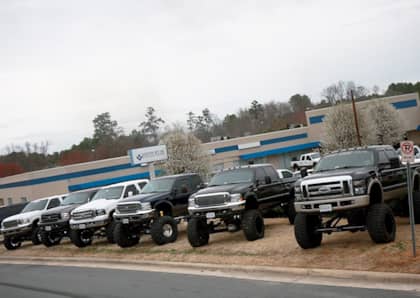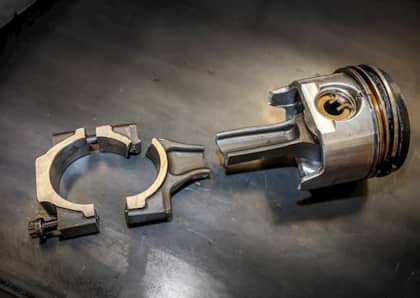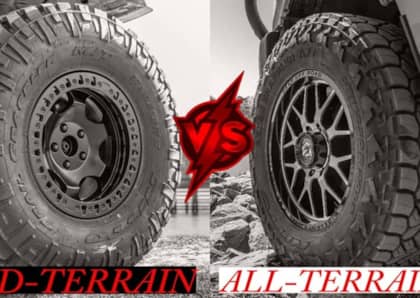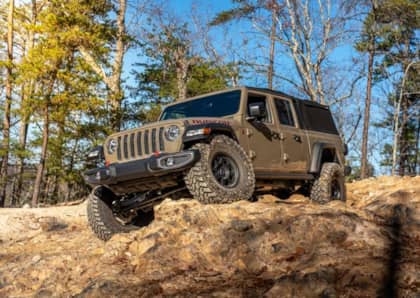Product Spotlight: Mishimoto’s Upper Support Bar for the 6.4L Power Stroke
For years, 6.4L Power Stroke owners have suffered from cooling system-related failures. At this point, it’s long been established that the factory radiator is prone to leaking where the plastic end tanks are crimped onto the aluminum core. Once the end tank(s) separates from the core or (in other cases, cracks), an annoying and persistent coolant leak ensues.
Rather than simply replacing the failed factory unit with an OEM replacement and hoping for better longevity, many folks invest in the all-aluminum version manufactured by Mishimoto. The company’s direct, drop-in radiator features aluminum end tanks TIG-welded to a 100 percent brazed aluminum core and comes with co-molded aluminum/rubber mounting pegs to reduce the amount of chassis flex imposed on it.
In addition to offering a more durable radiator, Mishimoto looked beyond the construction of the OEM unit itself to get to the bottom of the issue. The company’s findings pointed to a structurally weak radiator core support — and its engineers promptly got to work on a solution. After extensive R&D was poured into the project, Mishimoto released their upper support bar for the 6.4L Power Stroke. Its heavy-duty steel construction and cast-steel anchor points (among other features) add uncompromising rigidity to the upper radiator area, which further limits the amount of flex that occurs in this vital region.
Read on for a closer look at the ultimate fix for your 6.4L Power Stroke’s radiator woes.
Inferior Factory Part

As the chassis flexes on ’08-’10 Ford Super Dutys, increased stress and wear is placed on the components that are structurally obligated to the frame — one of which is the radiator. While investigating possible contributors to the leaking radiator problems that plague the 6.4L Power Stroke, the folks at Mishimoto discovered a severe lack of rigidity in the upper portion of the radiator core support assembly (arrow). While the excessive give of the factory upper radiator support can’t be singled out as the primary reason for this engine’s notorious radiator issues, it likely contributes greatly to the problem.
30 Minutes or Less

After removing the mounting bolts that secure the 6.4L’s intercooler to the upper radiator support and the fasteners that attach it to the truck itself, the factory support can be removed. Breaking the support free often requires the use of a pry bar on each end. The entire process of removing the old support and installing the new Mishimoto piece takes approximately 30 minutes.
Stock vs. Rock

The structural makeup of the factory upper support bar (top) is magnesium — a lightweight alloy. Full steel construction was selected for the Mishimoto unit (bottom), with thick, welded tubular steel being employed in the center section. Further speaking to the heavy-duty nature of the Mishimoto upper support bar, it weighs in at 18 pounds. The factory piece tips the scales at just 6 pounds.
Heavy-Duty End Plates

As for the mounting points, the Mishimoto support bar (bottom) utilizes cast anchor plates for maximized durability, whereas the factory unit is all one thin magnesium piece. The Mishimoto support bar also provides clearance for a larger cold side intercooler pipe (a common aftermarket upgrade). Customers that retain the stock upper support bar but who want a non-restrictive, larger diameter cold side intercooler pipe have no choice but to notch out a section in the factory support.
New Mounts and Hardware

In the photo above, you can see the mounting bracket area on the back passenger side of the Mishimoto upper support bar. Four bolts (two per side) attach the upper radiator mounting brackets to the upper radiator support bar. Both new brackets and new hardware come with the Mishimoto upper support bar.
28 Percent Less Flex

As mentioned, the primary purpose of the Mishimoto upper support bar is to reduce flex in the entire radiator area. It accomplishes this by isolating the front sheet steel from frame twist, which we’re told reduces flex by as much as 28 percent. Reduced pliability in the upper radiator support means less strain on the factory radiator end tanks — which results in a reduced chance of the plastic end tanks separating from the aluminum core.
Take Notes

The six bolts that secure the top of the support bar to the truck are reused. It’s important to note here that these fasteners (three per side) are of varying diameter. Long story short, it pays to mark them or make a mental note of where each bolt installs.
Compatible With Stock or Aftermarket Radiators

Mishimoto’s upper support bar is compatible with both the factory 6.4L radiator and its aftermarket version, making its appeal multifaceted. In the photo above you can see the upper support bar working in conjunction with both Mishimoto’s aluminum drop-in radiator (notice the precision TIG welds on the end tank) and its polished cold side intercooler pipe.
The Hood Latch Mechanism

During the install of Mishimoto’s upper support bar, the hood release cable and latch mechanism have to be swapped over. To ease the swap, Mishimoto supplies all-new hardware for remounting the hood latch mechanism. New bump stops and nuts (which lock the bump stops in place) are also included and usually require a few adjustments in order to get the hood to latch perfectly.
Better Functionality, Durability and Performance

The truck’s horn assembly (which mounts behind the fuel cooler on 6.4L-powered ’08-’10 Super Dutys) also has to be swapped onto the Mishimoto support bar (arrow). Once again, Mishimoto includes a new fastener for this remounting process. In addition to being equipped with Mishimoto’s aluminum radiator, upper support bar and 3-inch-diameter polished, cold-side intercooler pipe kit, this particular truck has also been graced with a Mishimoto intercooler. The company’s intercooler has proven capable of lowering exhaust gas temperatures by 150 degrees in 6.4L applications.











